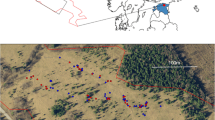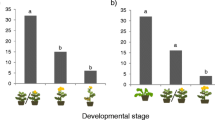Abstract
By impacting performance of individual offspring, oviposition site choice can have a large influence on female fitness; however, a female’s fitness is also impacted by her own survival and future reproductive potential. Factors influencing oviposition site selection include a female’s own predation risk and nutritional needs, as well as the performance of offspring. Trade-offs may occur when oviposition sites differ in their favorability for these fitness-related functions. Adults of the leaf-mining moth, Phyllocnistis populiella, forage at the extrafloral nectaries (EFNs) of quaking aspen, Populus tremuloides. Females are synovigenic and likely rely on adult nutrition for egg production; however, proximity to EFNs may be associated with reduced offspring survival. In a controlled experiment, when given the choice of oviposition on either a leaf with or without EFNs, P. populiella preferred leaves lacking EFNs. Seven years of field survey data revealed significantly higher oviposition and lower egg predation on leaves lacking EFNs. Aspen shoots with a higher proportion of leaves expressing EFNs experienced higher oviposition but no difference in egg predation. At the leaf level, eggs were overdispersed when at low to moderate densities, likely to decrease interference competition. Females mated multiply, and the acquisition of spermatophores through repeated matings may decrease P. populiella’s reliance on EF nectar for egg production. P. populiella appears to balance the trade-off between resource rich and high offspring performance sites by ovipositing in neighborhoods with a high proportion of leaves bearing EFNs, while preferring leaves lacking EFNs which experience lower egg predation.




Similar content being viewed by others
References
Chew FS, Robbins K (1984) Egg-laying in butterflies. In: Vane-Wright RI, Ackery PR (eds) The biology of butterflies. Academic Press, London, pp 65–79
Condrashoff S (1964) Bionomics of the aspen leaf miner, Phyllocnistis populiella Cham. (Lepidoptera: Gracillariidae). Can Entomol 96:857–874
Cordero C (1999) Is spermatophore number a good measure of mating frequency in female Callophrys xami (Lycaenidae)? J Lepid Soc 53:169–170
Courtney SP, Kibota TT (1990) Mother doesn’t know best: selection of hosts by ovipositing insects. In: Bernays EA (ed) Insect–plant interactions, vol 96. CRC Press, Boca Raton, pp 161–188
Craig TP, Itami JK (2008) Evolution of preference and performance relationships. In: Tilmon K (ed) Specialization, speciation, and radiation. The evolutionary biology of herbivorous insects. University of California Press, Berkeley, pp 20–28
Doak P, Wagner D, Watson A (2007) Variable extrafloral nectary expression and its consequences in quaking aspen. Can J Bot 85:1–9
Doak P, Wagner D (2015) The role of interference competition in a sustained population outbreak of the aspen leaf miner in Alaska. Basic Appl Ecol. doi:10.1016/j.baae.2015.04.001
Dong JW, Pan HS, Lu YH, Yang YZ (2013) Nymphal performance correlated with adult preference for flowering host plants in a polyphagous mirid bug, Apolygus lucorum (Heteroptera: Miridae). Arthropod Plant Interact 7:83–91
Gripenberg S, Mayhew PJ, Parnell M, Roslin T (2010) A meta-analysis of preference-performance relationships in phytophagous insects. Ecol Lett 13:383–393
Jaenike J (1978) On optimal oviposition behavior in phytophagous insects. Theor Popul Biol 14:350–356
Jervis MA, Boggs CL, Ferns PN (2005) Egg maturation strategy and its associated trade-offs: a synthesis focusing on Lepidoptera. Ecol Entomol 30:359–375
Mangel M (1987) Oviposition site selection and clutch size in insects. J Math Biol 25:1–22
Marshall DJ, Uller T (2007) When is a maternal effect adaptive? Oikos 116:1957–1963
Mayhew PJ (1997) Adaptive patterns of host-plant selection by phytophagous insects. Oikos 79:417–428
Mortensen B, Wagner D, Doak P (2011) Defensive effects of extrafloral nectaries in quaking aspen differ with scale. Oecologia 165:983–993
Mortensen B, Wagner D, Doak P (2013) Parental resource and offspring liability: the influence of extrafloral nectar on oviposition by a leaf mining moth. Oecologia 172:767–777
Poirier LM, Borden JH (1991) Recognition and avoidance of previously laid egg masses by the oblique-banded leafroller (Lepidoptera: Tortricidae). J Insect Behav 4:501–508
Renwick JAA, Chew FS (1994) Oviposition behavior in Lepidoptera. Annu Rev Entomol 39:377–400
Ruhren S, Handel SN (1999) Jumping spiders (Salticidae) enhance the seed production of a plant with extrafloral nectaries. Oecologia 119:227–230
Scheirs J, De Bruyn L (2002) Temporal variability of top-down forces and their role in host choice evolution of phytophagous arthropods. Oikos 97:139–144
Scheirs J, Bruyn LD, Verhagen R (2000) Optimization of adult performance determines host choice in a grass miner. Proc R Soc B 267:2065–2069
Scheirs J, Zoebisch TG, Schuster DJ, De Bruyn L (2004) Optimal foraging shapes host preference of a polyphagous leafminer. Ecol Entomol 29:375–379
Sisterson MS (2012) Host selection by Homalodisca vitripennis: the interplay between feeding, egg maturation, egg load, and oviposition. Arthropod Plant Interact 6:351–360
Sugiura S, Yamazaki K, Yamaura Y (2007) Intraspecific competition as a selective pressure on the choice of oviposition site in a phytophagous insect. Biol J Linn Soc 92:641–650
Taylor RM, Pfannenstiel RS (2008) Nectar feeding by wandering spiders on cotton plants. Environ Entomol 37:996–1002
Thompson JN (1988) Evolutionary ecology of the relationship between oviposition preference and performance of offspring in phytophagous insects. Entomol Exp Appl 47:3–14
Thompson JN, Pellmyr O (1991) Evolution of oviposition behavior and host preference in Lepidoptera. Annu Rev Entomol 36:65–89
Ulmer B, Gillott C, Erlandson M (2003) Conspecific eggs and bertha armyworm, Mamestra configurata (Lepidoptera: Noctuidae), oviposition site selection. Environ Entomol 32:529–534
Vasconcellos-Neto J, Monteiro RF (1993) Inspection and evaluation of host plant by the butterfly Mechanitis lysimnia (Nymph., Ithomiinae) before laying eggs: a mechanism to reduce intraspecific competition. Oecologia 95:431–438
Wertheim B, van Baalen EJA, Dicke M, Vet LE (2005) Pheromone-mediated aggregation in nonsocial arthropods: an evolutionary ecological perspective. Annu Rev Entomol 50:321–346
West SA, Cunningham JP (2002) A general model for host plant selection in phytophagous insects. J Theor Biol 214:499–513
Wooley SC, Donaldson JR, Stevens MT, Gusse AC, Lindroth RL (2007) Extrafloral nectaries in aspen (Populus tremuloides): heritable genetic variation and herbivore-induced expression. Ann Bot 100:1337–1346
Young B, Wagner D, Doak P, Clausen T (2010) Induction of phenolic glycosides by quaking aspen (Populus tremuloides) leaves in relation to extrafloral nectaries and epidermal leaf mining. J Chem Ecol 36:369–377
Acknowledgments
Funding was provided by a National Science Foundation award (DEB 0543632) to DW and PD and by the 2010 Institute of Arctic Biology Graduate Student Summer Research Fellowship to RD. UAF Life Science Informatics provided computer and software support. We acknowledge those who assisted with data collection and compilation: B. Carlson, A. Cushing, S. Fischer, T. Fristoe, Z. Meyers, B. Parks, and S. Wilbur. D. Sikes provided comments on an earlier version of the manuscript.
Author information
Authors and Affiliations
Corresponding author
Additional information
Handling Editor: Heikki Hokkanen.
Electronic supplementary material
Below is the link to the electronic supplementary material.
Figure S1
Total oviposition by Phyllocnistis populiella on Populus tremuloides leaves with (gray bars) and without (open bars) extrafloral nectaries (EFNs) leaves displayed by site and year. Points are backtransformed estimates (±1 SE) from the Poisson generalized linear mixed model (GLMM). (DOCX 66 kb)
Rights and permissions
About this article
Cite this article
Dennis, R., Doak, P. & Wagner, D. Aspen leaf miner (Phyllocnistis populiella) oviposition site selection mediated by aspen (Populus tremuloides) extrafloral nectaries. Arthropod-Plant Interactions 9, 405–413 (2015). https://doi.org/10.1007/s11829-015-9380-1
Received:
Accepted:
Published:
Issue Date:
DOI: https://doi.org/10.1007/s11829-015-9380-1




